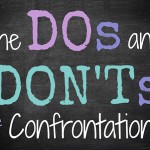 Confrontational tolerance refers specifically to the ability, willingness or intention to elevate a positive tension in the relationship. One way to put it is: “How many times can you be told ‘no’ before blowing a fuse?” So raising your ability to handle rejection builds confrontational tolerance. However, most people suffer from their “fear of rejection.”
Confrontational tolerance refers specifically to the ability, willingness or intention to elevate a positive tension in the relationship. One way to put it is: “How many times can you be told ‘no’ before blowing a fuse?” So raising your ability to handle rejection builds confrontational tolerance. However, most people suffer from their “fear of rejection.”
If your tendency is to avoid challenging conversations, you are not alone. Frequently, the cause of such avoidance is either lack of skills or an aversion to conflict and confrontation. If you have poor communication skills you will frequently experience rejection so this makes future communications uncomfortable. Human beings engage in a variety of unique strategies to address or avoid confrontation and conflict, mostly to avoid confrontation.
Let’s start with What Not to Do:
Do you ever do any of these 7 common ineffective behaviors?
- Avoid situations by dodging encounters with someone you’re having a problem with.
- Hold back saying what’s really on your mind, or say yes when you mean no just to keep the peace.
- Use sarcasm or jokes instead of taking an issue seriously to get to the bottom of it.
- Cut people off or change the subject when a conversation doesn’t go in the direction you’d like.
- Become defensive and redirect the conversation toward what’s “wrong” with someone, their stance or their style in dealing with an issue.
- Use sweeping generalizations or hurl personal insults in an attempt to get your point across or make another person wrong (e.g., “You always …” or “You never…”)
- Be unwilling to look critically at your own position or behavior and how it’s impacting the situation.
6 Tips for Effective Communication: Switch to these constructive approaches.
- Determine exactly what you are addressing The nature and severity of the issue will determine, in part, how the conversation should be framed and how it unfolds.
- Know your purpose for having the conversation, what you desire in terms of an outcome. Stay focused on and true to the purpose of the conversation,
- Choose the right time and place. Just don’t stay in your own corner, hoping that the issue will somehow magically disappear.
- Maintain a positive environment and direct that energy toward a useful purpose.
- Strive for mutual understanding with heightened awareness. Don’t presume that you know what someone else thinks or how they feel in a given situation.
- Separate evidence from interpretation. Getting to the core of an issue by separating fact from perception early on during a conversation will result in a more successful (not to mention shorter) dialogue.
Build Confrontational Tolerance for Improved Outcomes.
Becoming comfortable with having a difficult conversation is not an event, but rather a process. The first step to building confrontational tolerance is simply to reflect on how you typically respond under trying circumstances, and evaluate your own level of effectiveness. A second step might involve asking for feedback from people you trust about how they view your ability to handle challenging or stressful situations. And the final step is practice, practice, practice.
In closing this topic it is worth mentioning that the top successful 10% of people mostly have improved their Confrontational Tolerance. It is a skill, so learn it and avoid a life of mediocrity instead of avoiding a life with confrontation. It’s your choice.
Yours in Life,
docMIKE

 Follow
Follow

No Comments